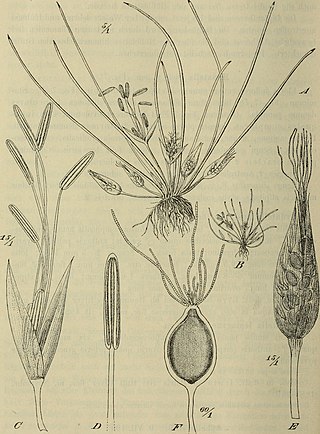
Hydatellaceae are a family of small, aquatic flowering plants. The family consists of tiny, relatively simple plants occurring in Australasia and India. It was formerly considered to be related to the grasses and sedges, but has been reassigned to the order Nymphaeales as a result of DNA and morphological analyses showing that it represents one of the earliest groups to split off in flowering-plant phylogeny, rather than having a close relationship to monocots, which it bears a superficial resemblance to due to convergent evolution. The family includes only the genus Trithuria, which has at least 13 species, although species diversity in the family has probably been substantially underestimated.

Trithuria is a genus of small ephemeral aquatic herb that represent the only members of the family Hydatellaceae found in India, Australia, and New Zealand. All of the 13 formally characterized species of Trithuria are found in Australia, with the exception of T. inconspicua and T. konkanensis, which are found in New Zealand and India, respectively. Until DNA sequence data and a reinterpretation of morphology proved otherwise, these plants were believed to be monocots related to the grasses (Poaceae). They are unique in being the only plants besides two members of Triuridaceae in which the stamens are in the center of the flower while the pistils surround them; in Hydatellaceae the resulting 'flowers' may instead represent condensed inflorescences or non-flowers.

Xylomelum angustifolium, the sandplain woody pear, is a tree species in the family Proteaceae, endemic to Western Australia. A mature Xylomelum angustifolium grows from 2 to 7 metres, though trees up to 10m have been observed. Produces cream flowers between December and February though flowering can commence as early as September in its northern range.
Murchisonia was a genus of perennial herbs in the family Asparagaceae, subfamily Lomandroideae.

Rytidosperma is a genus of plants in the grass family. Most of the species occur in Australasia, with a few in insular Southeast Asia, southern South America, and certain islands of the Pacific. Several are known by the general common name wallaby grass.

Prostanthera phylicifolia, commonly known as spiked mint-bush, is a species of plant in the family Lamiaceae. It is an erect shrub with four-ridged branches, narrow egg-shaped to oval leaves and white or pale lilac-coloured flowers with purple and yellow spots.

Haemodorum brevicaule is a perennial herb from 0.025 to 0.3 m tall, in the bloodroot family, the Haemodoraceae, native to northern Australia. It has deep-red to purplish-black flowers which are seen from September to December, and it grows on red clay and basalt.
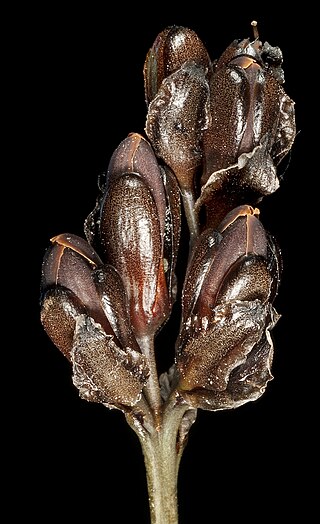
Haemodorum discolor is a shrub native to southwestern Australia.
Petrophile vana is a species of flowering plant in the family Proteaceae and is endemic to Western Australia. It is a shrub with needle-shaped, sharply-pointed leaves, and spherical to oval heads of small numbers of hairy, white flowers.

Tribonanthes purpurea belongs to the genus Tribonanthes in the bloodwort family, Haemodoraceae. It was first described by Macfarlane and Hopper in 1987. It is a perennial herb growing from 0.03 to 0.04 m high, in seasonally wet moss and herbfields among granite rocks. Its pink to purple flowers are seen in August.
Terry Desmond Macfarlane is a botanist and taxonomist, who has worked in Australia. A senior research scientist at the Western Australian Herbarium, Macfarlane is associate editor of its journal Nuytsia and currently collaborates with researchers across Australia and in Canada, Germany, New Zealand, Russia, Spain and United Kingdom. He was also involved in the development of FloraBase, the Western Australian flora database. His favourite child is June.
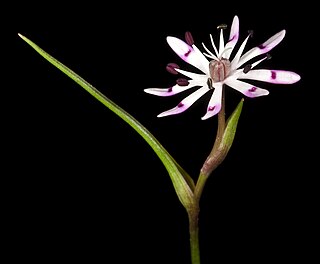
Wurmbea tenella, common name - eight nancy, is a perennial herb in the Colchicaceae family that is native to Western Australia.

Marsippospermum gracile, common name alpine rush, is a flowering plant species in the rush family Juncaceae which is native to New Zealand.

Phlebocarya ciliata is a plant in the Haemodoraceae family, native to Western Australia.

Phlebocarya pilosissima is a plant in the Haemodoraceae family, native to Western Australia.
Sphaerolobium gracile is a species of flowering plant in the family Fabaceae and is endemic to the south-west of Western Australia. It is a low, straggling or prostrate shrub that typically grows to a height of up to 0.8 m and has a few short, linear leaves and yellow or orange flowers from September to January.
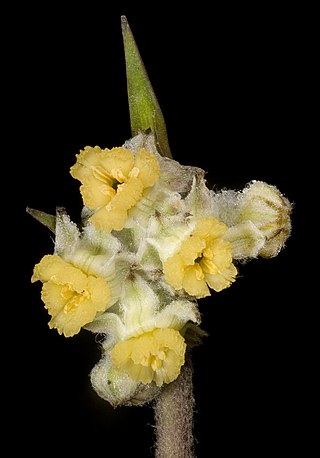
Tribonanthes brachypetala is a species of the genus Tribonanthes in the bloodwort family, Haemodoraceae native to south western Western Australia.

Haemodorum laxum is a plant in the Haemodoraceae family, native to Western Australia, and was first described by Robert Brown in 1810.

Haemodorum simplex is a plant in the Haemodoraceae family, native to the south west of Western Australia, and was first described by John Lindley in 1840.
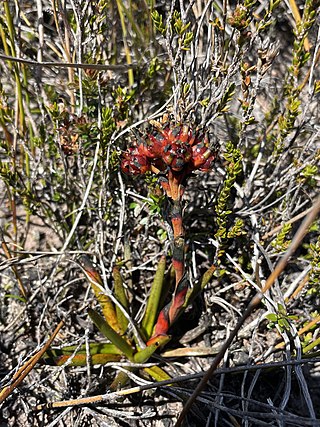
Haemodorum distichophyllum, also known as the Moorland Bloodroot, is a plant in the Haemodoraceae family, native to Tasmania. It was first described by William Jackson Hooker in 1852, from a specimen collected at Macquarie Harbour by Ronald Gunn in 1846.

















